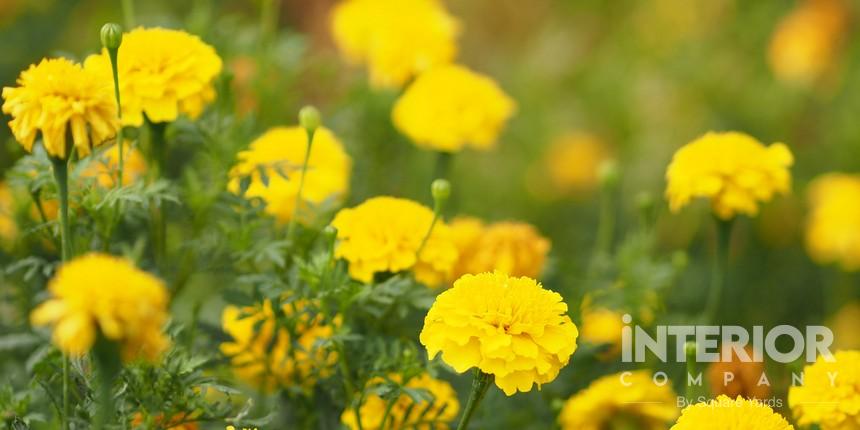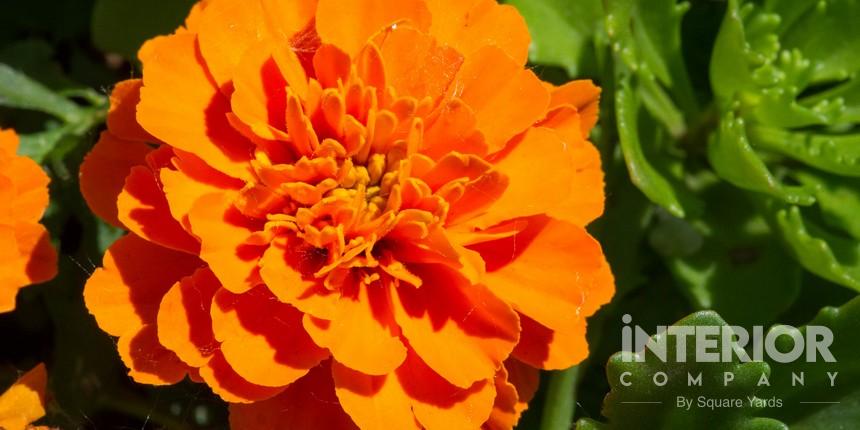- Kitchens
- Design Ideas
- Cities
- Trends
- Guides
- Price Calculators
- Our PortfolioNEW
- More
- Home
- Trends
- Furniture And Decor
- Indoor Plants
- Marigold How To Grow At Home Indp
Marigold: How to Grow at Home?
Marigold flowers are one of the most popular species of annual grows amongst gardeners from every coast. And why shouldn’t they be? Their blooming period is quite long plus their vibrant hues of yellow, rust, and orange make one of the best additions to your gardens, baskets, or pots. You can always experiment with them by adding marigold plants to the borders for enhancing the look of your backyard. Marigold imparts an aroma that has a sense of spiciness and undoubtedly gives a splash of color to your garden throughout the summer.
Table of Content
Usually, marigold flowers are quite tolerant to diverse weather and soil conditions, but they bloom their best in heat. You will find many types of marigolds ranging from miniatures to giant versions and they are one of the best insect repellents. Hence, can be grown with your vegetables and fruits to keep the bugs away. But every plant or flower demands some specific conditions for full-fledged growth. Here we have put up a guide to take you down the lane of the marigold plant in the entirety. Have a look!
The Various Types of Marigolds
French Marigolds

This variety of marigold blooms well in summer and fall and because of its sturdiness, these can also be grown in a container indoors. A temperature scale of 70 -75 degrees Fahrenheit is ideal for marigold flower seeds to grow. After planting marigold seeds, you can spot the sprouting within a week, but you need to be careful of beetles, snails, and other pets that can turn out to be quite dangerous for the plant. French marigolds also have different types like:
- Bonanza Marigolds are the type of French marigolds which are almost 8 to 10 inches in height. The flowers appear in the shades of orange, maroon, or yellow and are surely eye candy.
- Janie marigolds are a variety that will resemble a lot to double carnations. The average height for these marigold plants is 8 inches and the flowers are in the hues of orange, maroon, and yellow. These are best for limited spaces.
- Little hero marigolds are one of the dwarf varieties of marigold with a height range of 6 to 8 inches, but it also has flowers that are in similar shades as that of bonanza and Janie marigolds.
Signet Marigolds

One specialty of this kind of marigolds is that they are edible, and people often use these flowers to add sweetness to their salads. The signet marigolds will grow well in your usual garden as well as the herb garden. Signet marigolds should be kept in full sun and when you google them, you can find tons of ways to use them in various recipes. The soil conditions for this plant should be moist but being fertile is not a mandate because it can lead to a weak structure of the plant. Some flowers of this marigold can be maroon in color with their tip being yellow known as the paprika gem marigold. In case the soil dries up, you should water, and removing the spent flowers will make the growth process.
African Marigolds

The bloom of this plant is quite large, and it is popularly known as Aztec or American Marigold. This aspect makes them ideal for decorations, flower arrangements, and bouquets. Similar to other varieties of marigold, these also blooms fully in sunny areas. Animals like rabbits and deer which can harm the garden are kept at bay because of the strong smell. In comparison to French marigolds, these flowers are more capable of withstanding dry weather conditions. Also, the reason why these get their name as Aztec is that once the Aztecs made use of these marigolds as a yellow dye, for medicinal uses, and decorations.
Triploid Hybrids

As the name suggests, these marigolds are a crossover of American and French marigolds. The flowers produced by these plants are quite large and can grow in extreme weather conditions as well. Though these can handle tough weather conditions, they don’t need to be easy to grow too. The germination of these marigold plants is low hence, it could be a challenge to grow them but when the basic conditions are met, they also grow fully like other marigolds.
Triploid hybrids are often referred to as mule marigolds because they are unable to reproduce. All you have to do is take care of the pointers that come with the plant. One of the main advantages of triploid hybrids is that they produce blooms for a long time because they aren't germinating the seeds as they grow.
Read More About :- How to Grow Stapelia Plant
Desert Marigolds

Choosing a plant for conditions like dry, windy, and the hot climate becomes daunting because at times even the best efforts by the gardener prove to be futile. If you live in such conditions, try growing desert marigolds as these marigold plants are known to be tough survivors. The scientific name for these flowers is Baileya Multiradiata and it is popularly called paper daisy because its mature flowers have a texture similar to paper. Usually, these can grow up to a foot in height with huge yellow blooms and a lot of seeds. A few of them that are mounds and clumping of daisy flower can be of shorter height. The life span is short, and they are herbaceous perennials that return after a year. These do not require much care as they are the toughest ones of the marigolds.
All that you need to know about harvesting marigold seeds
Marigolds are one of the mainstream blooms found in many gardens because they are easy to take care of and grow using marigold seeds. If you are aware of saving these seeds, you will not have to buy a new sapling every season. Also, if you have multiple Marie gold flower plants, you can prepare some packets of marigold flower seeds and use them as a gifting option. Since marigold plants are a hybrid species, the growing plant will be similar to one of the parent plants. Here's what you need to take care of while saving marigold flower seeds.
- Make sure that the marigold seeds have dried out before harvesting. You should wait till the seed pod turns brown from the bottom but should have some green hue remaining at the lowest level. For harvesting, you need to separate the marigold bud from the stem.
- Open the removed seed pod and get a paper towel handy. Hold the base of the pod and separate the leaves and seeds from it. You will have the seeds attached to the base and you keep them safely on the paper towel.
- The seeds are thin and long with one end being darker in color and the other being lighter. Let the seeds dry completely on the paper and do not cover them because this will help in preserving them, so they don't turn bad in storage.
- Keep your marigold seeds in a paper envelope and avoid using polybags as this can cause moisture to get in seeds. You can use these seeds in the spring which comes forth after the frost during which the seeds were preserved.
What about the marigold blooms?
Marigold flower appreciates moisture and warm weather conditions. The growth begins at a temperature of 22 degrees Celsius and continues till 35 degrees Celsius. Usually, the marigold flowers start appearing at the end of December and continue to grow till march end, but the most visible growth is from February to the end of March. The last bloom remains till the end of autumn and the beginning of frost. In case you have indoor marigold flowers, they will continue to grow even if the temperature outside goes beyond their blooming conditions.
Marigolds love the spring season which is in between January to March in most of the countries. You can grow marigold in almost every part of the world, but you will have to wait for spring or the weather conditions to turn warm. Since the marigold flower is a perennial one, summers serve them the best. If you can protect your flowers from extremely harsh and direct heat, you will have beautiful flowers in the shades of orange, yellow, and maroon on your plant.
When it comes to winters, it depends on the temperature whether the marigold will bloom or not. In countries where the frost is extreme, you will not see a marigold plant blooming. If you live in the Indian subcontinent, Africa, or Asia, your marigold can bloom during winters too.
In any case, you should always feed your plants with fertilizers containing nitrogen because they will help your plant to turn out sturdy and sustainable.
Another aspect about marigold is that it blooms every season, but the quality of bloom starts to diminish after the second growth. For planting the marigolds, you can either use the seeds or the cuttings from a fully grown plant. If you are planting fresh seeds, it usually takes 50-70 days to see the bloom and if you are using the plant cuttings, it will take around 45-60 days to see the growth.
Things to know about planting, propagating, and growing marigold seeds
The time of planting– The species that belong to the taller and African ones should be planted in the spring season when the harshness of the frost is over. When you start growing these taller species early in the season, they get more time to grow and flourish. The signet and French species can be grown through the spring and during mid-summer.
The ideal area to plant– Usually, every species of marigold prefers the area with good sun, but they also appreciate some shade. At the time of harsh heat, some shade in the afternoon helps in better growth. The erecta varieties should be protected from strong winds and heavy rainfall and to support them some light staking would be beneficial.
The process of planting– Marigolds are quick to germinate, show signs of sprouting in a few days, and start blooming in a period of 8 weeks, which makes them an easy-to-grow option from seeds. You can sow the seeds directly after the extreme winter conditions are gone and the soil has begun to regain warmth. Keep the seeds 1 inch apart from each other and ensure proper watering is done. When the seeds start to sprout, thin them accordingly. The signet and French varieties should be 8-10 inches away and the African ones should be 10-12 inches away.
It is recommended to use small shears or landscape scissors for separating the seedling or else the roots of the remaining seedlings can suffer damage. The seeds can be planted inside the house and can be transplanted to soil outside when they are 2 inches tall. If you are transplanting a marigold sapling brought from a nursery then you should dig the soil at least 6 inches deeps. Fill in the soil again after putting the seeds or sapling and firmly press. Ensure to water them regularly. The addition of some mulch in between the plants will keep a check on the moisture levels of soil and prevent any weeds.
Tips to care for your marigold plants
- Regular deadheading will give a better appearance to the plant and will help in the proper growth of the plant. And believe it or not, pinching your newly grown plants will give them a bushier growth. You need to separate the new growth from the top.
- Though marigold plants are not the choosy ones when it comes to soil, they grow well in moderately fertile soil and a well-drained one. They will not perform well in clay soil or the areas which do not have well-drained soil.
- While you are transplanting the plant, you should go with adding fertilizers up to 5-10 inches. The marigold planted in the ground hardly requires a fertilizer for growth. To boost the foliage growth, fertilizer should be added in the early stage of growth. If it is a pot marigold, it is beneficial for the plant to add liquid but diluted fertilizer.
- Marigold should be watered at the base and not from the top because the flowerheads can get damaged with excessive moisture. During high heat, keep watering the soils regularly but let the soils dry in between the watering sessions.
- To preserve the seeds, remove the petals and leaves from the flowerheads and separate the seeds. For hybrid species, this will not be true.
The uses and benefits of marigold plant
Controlling the Nematode– The root-knot nematodes are very well controlled with a chemical that is emitted from the marigold plants. Nematodes are small soilborne worms that make the roots of vegetables and ornamental plants their food. The tangerine species are the most effective in controlling nematodes.
Attracting beneficial insects– Marigold tends to attract certain useful insects like bees, ladybugs, and wasps which are good for preventing the plant from aphids and other dangerous pests.
Enhancing the landscape– Marigolds are available in the hues of orange, yellow, and maroon which makes a great addition to your existing landscape.
Easy to care– Caring for marigold plants is the easiest. They are capable of handling heat, sun, rainfall, and almost every well-drained soil. You can grow them from seeds, transplants, and cuttings from other marigold plants.
We hope that this article inspires you to grow marigold plants and add value to your existing landscape.
Ready for a home transformation?
Let our designers assist you!
Recent Posts
Related Category
- Balcony
- Bedroom
- Home Decor
- Living Room
- Outdoors



































